|
July 23
There was a symphony of hippo calls in the night; they
sounded angry, like they were arguing. Coffee around the fire and
a quick bite of breakfast, and we were in the Landcruiser and on
the way before sunrise. We were scheduled to go on the river this
morning in dug-out canoes called mokoros, a traditional mode of
travel in the Okavango Delta.
As we drove through the early morning, the impala were
snorting their alarm calls and the hornbills were making a nervous
ruckus. Gee stopped to look and listen; he said there must be a
predator nearby. I wondered if it might be us
alarming the impala, but Gee said no, they never make the alarm
calls for vehicles, only for predators.
Sure enough, we rounded a bend and there was a female
leopard, sitting right in the road. I pointed to it excitedly.
“Good spot” said Gee ironically - it would have been
impossible to miss. (Good spot
–get it? Pun intended!)
|
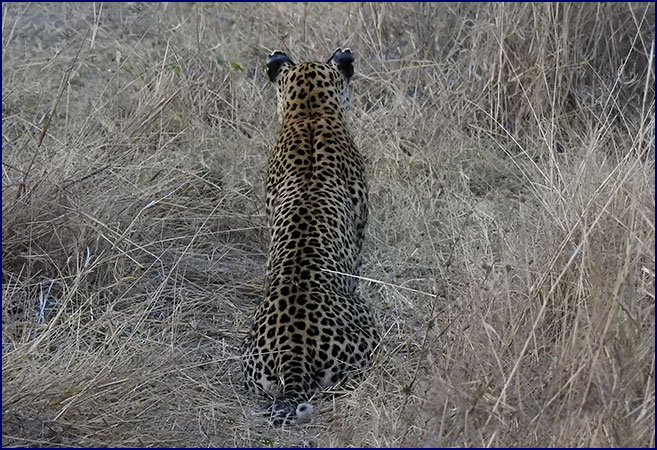
Leopardess
hunting in the early morning |
The hunting leopardess silently moved out of the road
and crouched in the grass, and the impala snorted and started
moving toward her. I was surprised by this, but Gee said that the
impala will try to keep a leopard in sight so that it can’t
sneak up on them. However the impala forget quickly, so if they
can’t actually see the predators they don’t believe they are
there. Both the impalas and the hornbills were still sounding the
alarm, alerting other species about the leopard; they help each
other out watching for danger - safety in numbers.
Leopards are very successful hunters, Gee told us.
Two hyenas heard the impala alarm
calls and came running across the fields toward us in the dim
light, no doubt hoping the leopard would make a kill so they could
steal it. The leopard hid in the tall grass, and the hyenas ran on
by.
|
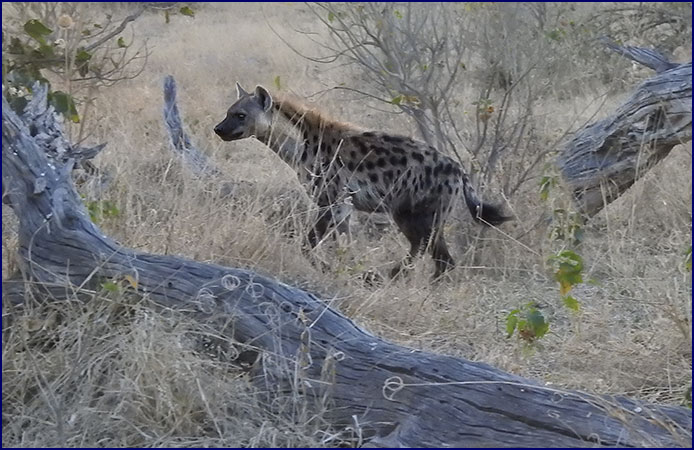
Spotted hyena
|
We passed a large abandoned termite hill that had larger
holes around the base. Gee said it was called a black
mamba hotel, because these snakes like to move into empty
termite hills. The black mamba is the most venomous snake in
Africa, he told us, and third in the world. They are also said to
be the fastest snake in the world, and can go up to 20 km per
hour. These slender snakes grow up to about 10 feet long. “If
you see a black mamba, don’t provoke it!” Gee said. Sound
advice.
|
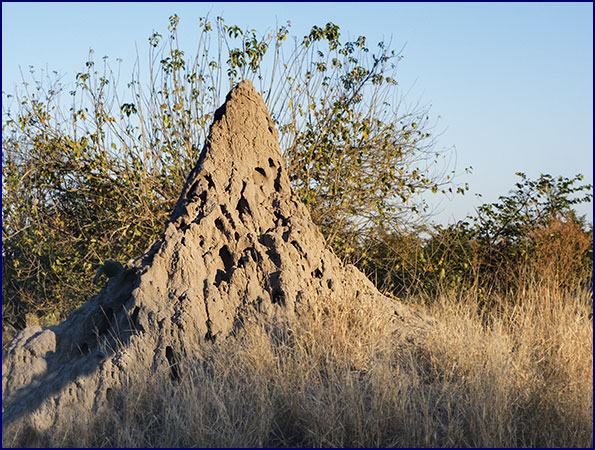
Black
Mamba hotel
|
Gee told us about the lifestyle of the termites. The queen
and king are in their chamber, and the workers feed them. There is
a fungus that grows inside the mound and the workers farm it as
their main source of food. The queen termite lives for about 15
years. There are millions of termites in each colony. When they
are establishing a new colony the queen will lay up to 30,000 eggs
per day, but once it is established she lays only as many eggs as
needed; if 10,000 termites are killed she will lay 10,000 new
eggs.
We were running late for the mokoros but Gee was
unconcerned; he seemed happy to linger and tell us about the
termites. He told us
how he and his father used to harvest them on the island. When the
termites hatch they will fly to the light, going until they are
exhausted, and then fall to the ground, shed their wings and start
to dig. Gee’s father would know when the hive was going to fly;
they would dig a big hole beside the mound, and put a sack in it.
Gee would shine a light in the hole to attract the termites, and
they would fly in and fill it.
Giant bullfrogs, genets, monitor
lizards and snakes would also come for the termites, but Gee’s
father would be ready with his spear, and they would be taken for
food. They would fill 4 or 5 sacks with termites, Gee told us, and
this was the ‘men’s work.’ In the morning it was time to
prepare the termites. They would be roasted over the fire, then
dried for three days, lightly salted, and then pounded into
butter. This was the ‘women’s work,’ Gee said. Termite
butter is very delicious, he told us.
We stopped by a hyena den, a large hole in the ground
probably originally made by aardvarks. There were no hyenas in
view, but mother and babies must have been inside - we could see
the fine mist of their breath coming up out of the hole in
the cold morning air.
|
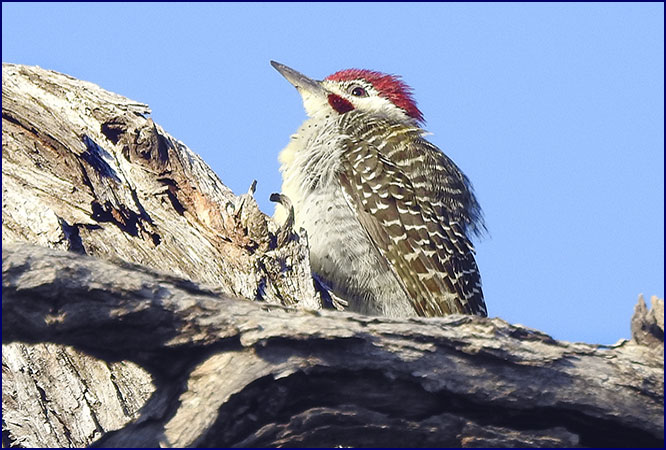
Bennet's woodpecker
|
Driving on, we spotted more new birds. A Bennet’s
woodpecker with a bright red crown clung to the side of a tree,
and we got a fleeting glimpse of a green wood hoopoe. A family of
lesser striped swallows sat on the side wall of a bridge, and from
this vantage point we could see a pied kingfisher perched on a log
and a green-backed heron in the marsh. My favorite was a
scimitar-billed hoopoe, a lovely dark blue bird with a long
curving bill like a hook.
|
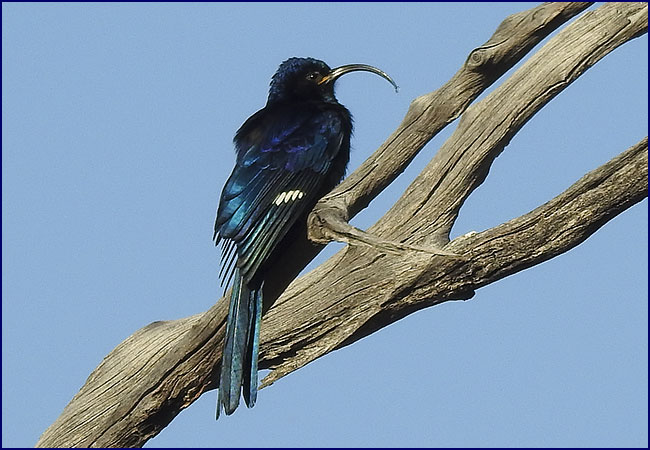
Scimitar-billed
hoopoe
|
We stopped to watch a troop of about thirty baboons. A huge
male sat by a big tree keeping watch, while the others moved about
the meadow. A mother sat on a log and kept an eye on a group of
youngsters as they played, running up and down the fallen tree,
leaping and swinging. The smaller babies rode sitting up on their
mothers’ backs, or hanging upside-down under her belly.
Baboons are very athletic, with
long lithe limbs. The mature males have a stern brow and often a
slightly belligerent expression. If the youngsters misbehave they
get in trouble; we saw one mother pick up a baby, bite him on the
head in reprimand, and then throw him back. Tough love.
|
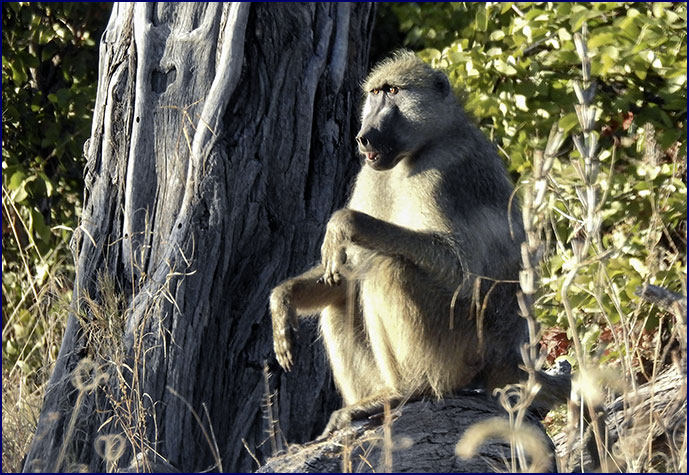
The dominant male baboon keeps watch.
|
We were half an hour late getting to the mokoros, but the
river guides didn't seem to care. These long flat canoes were
traditionally made by hollowing out logs, but the modern versions
are of fiberglass. The river was calm and flat, though we could
see a current flowing. A herd of elephants was browsing among the
trees on the far side.|
|
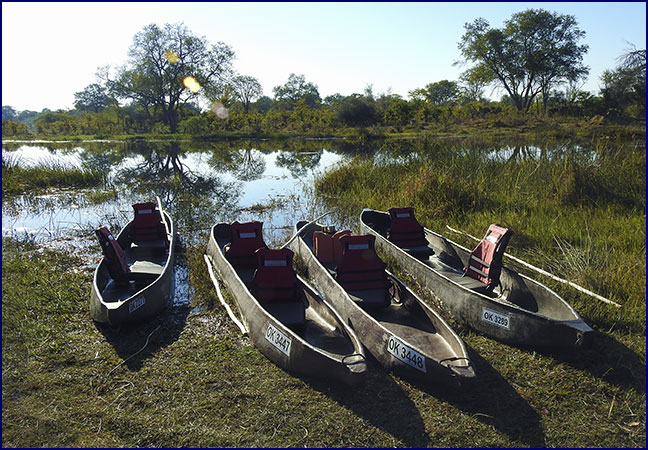
Mokoros, the
traditional mode of transport in the Okavango Delta.
|
We climbed into the mokoros, two of us in each boat, along
with a poler/guide. We sat on small cushions with our feet
stretched out in front of us while the polers, standing in the
back of the boat, pushed the mokoros up the river with a long
pole. Gee came as well, sharing with Natalie; he looked very
relaxed in the mokoro, as if he might take a nap on the river. We
glided silently over the water, and it was very serene and
peaceful.
We had barely started up the river when the elephants
crossed the water right in front of us. Our polers brought the
little boats to a stop, and we watched in wonder as the huge
matriarch waded into the water and made her way across, not more
than twenty meters from us. The rest of the herd followed closely,
more and more of them appearing out of the trees: Twenty, forty
– they kept coming; in the end we estimated there were about
eighty of them. Some were almost within spitting distance, and
others crossed further upstream. The adults could easily walk
across the shallow river, but the smallest babies paddled with
their heads barely above water. Some of them stopped mid-river to
eat some of the marsh grass or to drink. They were so close that
we were looking up at them; getting to watch them from this
perspective was an unforgettable experience.
I was sharing a mokoro with Tara. Our guide, Kelly, poled
us upstream, the morning sun bright in our eyes. The edges of the
river were thick with water lilies; Kelly told us the night lily
has serrated edges, while the day lily is smooth. He found a
little frog clinging to a reed and brought us up very close; it
was a beautiful little creature, cream colored with chestnut spots
and translucent reddish toes. Kelly told us it is also called a
bell frog (because it sounds like a bell), and Gee referred to it
as a delta leopard. I was amazed at how still it sat even when we
were taking photos from mere inches away.
|
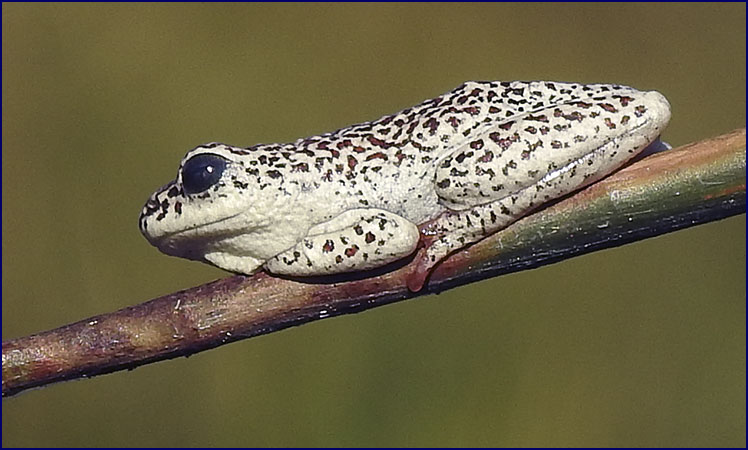
Reed frog
|
We stopped to look at an old hippo skull with huge teeth,
bringing the boats up close to the shore. As Kelly was telling us
about it, I was thinking how much I would love to get ahold of one
of those teeth as a souvenir - Tara had me beat though, she was
trying to figure out how to smuggle the whole skull home.
|
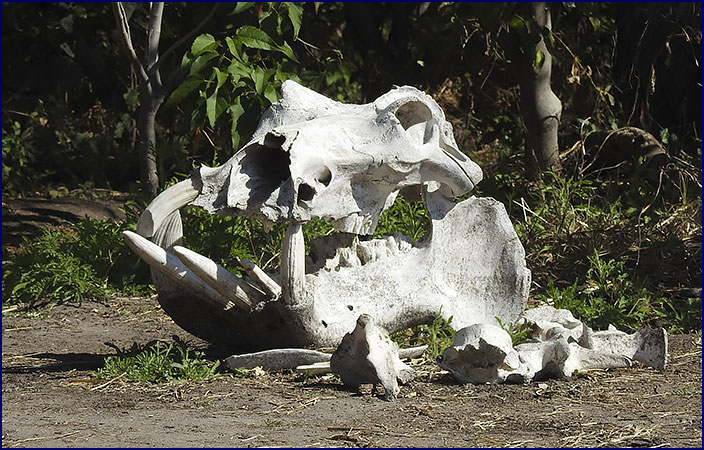
Hippo skull
|
A jacana ran across on top of the lilypads; we could see
why these leggy chestnut-colored birds are known as lily trotters,
and sometimes called Jesus birds because it appears as if they can
walk on water.
A reed cormorant stood on a stump with his wings outstretched to
dry in the sun, and a great egret looked down at us from a tree. A
pied kingfisher hovered above the river like a helicopter, its
black and white feathers gleaming in the sun. Flying in place like
a giant hummingbird, it would periodically dive straight down into
the water with a splash before coming back up to hover again,
usually having scored a small fish.
|
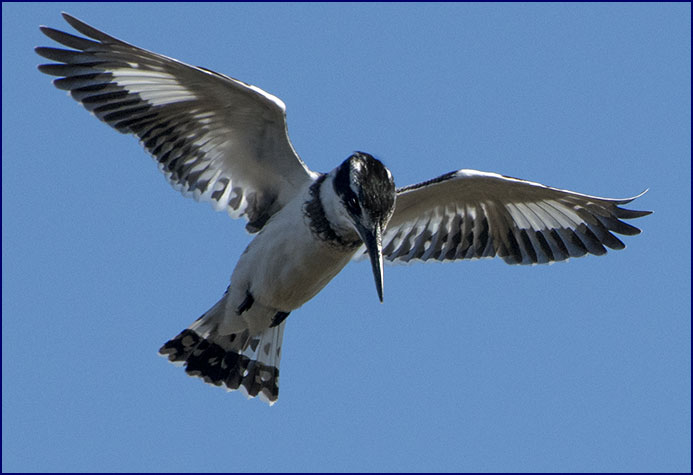
Pied kingfisher |
After traveling a good ways upstream and around a bend in
the river, the group stopped for a tea break, using an upside-down
mokoro for a table. When we headed back downstream we drifted with
the current, the guides standing in the back of the little vessels
using the pole to steer. The sun was at our backs and we could see
the reflections of the mokoros in the blue water. The river was
fairly shallow but we did see some deep spots. We asked Kelly what
is the maximum number of people that can fit in a mokoro before it
sinks - he said two. We were hopeful that didn't include the poler.
We
were back in the Landcruiser with Gee by shortly after eleven. We
passed another troop of baboons, or was it the same one again? Now
they were high up in the mopane trees, eating leaves. The
youngsters ran up and down the tree trunks like it was nothing.
Several adults were screeching and fighting, making quite a
racket. Gee pointed out a female with a very red butt – he said
that showed she was in estrus. Probably what the others were
fighting about.
Then Gee took us to the wild dog den. It was in a little
clearing in a lightly wooded area, and logs had been strategically
placed by the Kwai Rangers to
prevent people from driving too close. There were three dogs
sleeping, flat out on their sides in the shade, and another one
walked by as we watched. We could see dried blood on their necks
– they must have had a kill last night. With those big round
ears, hearing is the dogs’ keenest sense. They hunt as a pack,
singling out their prey and running after it tirelessly. They have
great stamina, so they can literally follow their quarry until it
is too exhausted to run.
Like most of the animals we had encountered, the dogs took
very little notice of us, briefly glancing up at the big
‘Landcruiser animal’ and then going back to sleep. Gee
explained that the African wild dog is extremely endangered; this
is partly because they need very large territories to hunt, and
farmers tend to shoot them on sight. Another thing that has
decimated their numbers is rabies; conservationists are now
working on a program to vaccinate them against it.
We heard a little yip from up
under the bushes; there were puppies! They were back in the
shelter of the bushes, but we could make out the mother dog lying
on her side while five or six small pups nursed, climbing over her
as they jostled for position. Then the pups got up and started to
move around; they couldn’t have been much more than three weeks
old. They were so adorable you just wanted to go play with them!
We could not believe how lucky we were to have a chance to see
them.
The mother dog got up and moved out from the bushes, and
the puppies followed on wobbly legs. More of them came out of the
den; we counted at least twelve. One by one the other dogs came
over to see the puppies, wagging their tails and greeting them
enthusiastically. The pups started to scamper around a bit,
following the adults; they were just getting old enough to learn
how to play.
It was really cool to watch how
the whole pack was so involved with the pups. Wild dogs are
normally on the move all the time, covering great distances; the
only time they stay in one place for long is when they have young
puppies. The whole pack helps provide food and care for the pups.
Leaving
the den, we came to a series of lagoons. There were hippos in the
water, two adults and a baby, floating like great buoyant logs. A
tall leggy bird called an African darter was swimming, its body
submerged and just its head and neck sticking up out of the water
like a snake.
A group of five bull elephants
came across the meadow, stopping by a stream to drink and just
hang out a while. They stood relaxed, several of them resting
their trunk over one tusk. Soon another group of ellies walked
right by us, moving silently, a big breeding herd of females and
youngsters. There were about a dozen of them, and they fanned out
in the swamp. We could see their temples vibrate as they
communicated with one another.
Gee drove the Landcruiser through quite a few water
crossings; some of them were deep enough that we thought we might
need that snorkel. Two tawny eagles surveyed the area from atop a
tree. We stopped at a termite mound to closely examine the
entrance to a black mamba hotel; the hole was probably dug by an
aardvark. A coppery-tailed coucal strode through the grass, a
striking black and copper bird with a white front and piercing red
eyes. Gee said that they are found only in the Okavango Delta, and
he told us they are nest robbers.
|
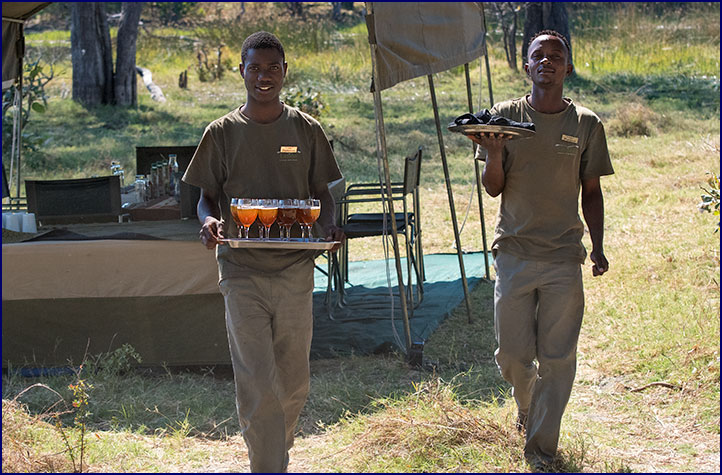
Phillimon
and Parker welcome us back from a drive.
|
When we arrived in camp we were greeted as usual by
Phillimon and Parker, bearing goblets of sweet bush tea, and moist
towels to wash away the road dust. Lunch and a bucket shower, and
we had a little while to relax and look around. The guys had done
a lot of work since breakfast, clearing the paths and finishing
the camp setup. The dining tent was right beside a marshy lagoon,
in a beautiful private setting. A fish eagle perched in a dead
tree on the edge of camp.
We headed out for the afternoon drive around 3:45. As we
left camp the fish eagle flew down the river, letting out an earie
lonesome cry that filled the air and sent chills down my spine. A
wattled crane waded in the shallow water, tall and elegant, with a
white head and neck and a cascade of long grey feathers over his
back and tail. He took wing and flew gracefully away.
|
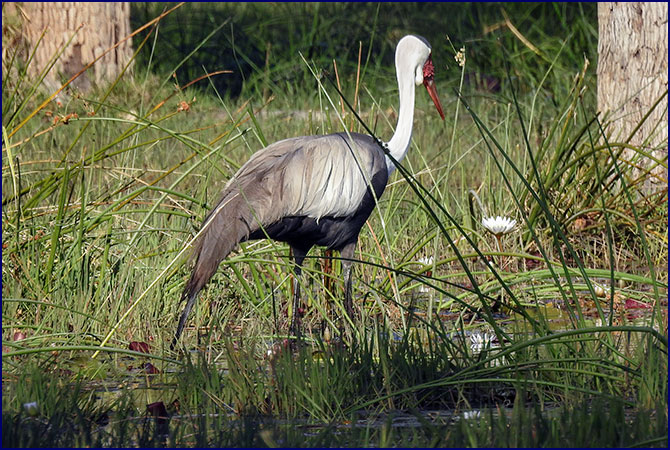
Wattled
crane
|
There were half a dozen red lechwe on the other side of a
small river, females and youngsters, and a bit further on we came
across a magnificent buck. These charismatic antelopes have rich
chestnut coats, and the males have long curving spiral horns.
Built with their hind legs longer than their front, the lechwe
have a distinctive downhill way of moving. Endemic to the Okavango
Delta, they are very adept at running and leaping through the
water to escape predators. We learned that they are Gee’s
favorite antelope.
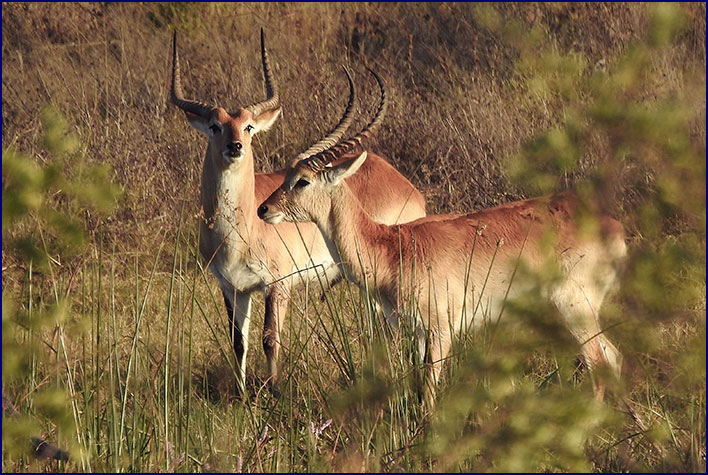
Red Lechwe
|
The abundant water made the area a haven for birds,
including many of the usual suspects such as doves, starlings,
Egyptian geese, sacred ibis, and shining white egrets. We added a
number of new birds to our list; the long-toed lapwing, the pied
cape wagtail, some painted snipes and a rufous-bellied heron. We
pointed cameras at a lilac-breasted roller taking off from a
branch; it is deucedly hard to catch those flamboyant little
buggers in focus when they fly!
|
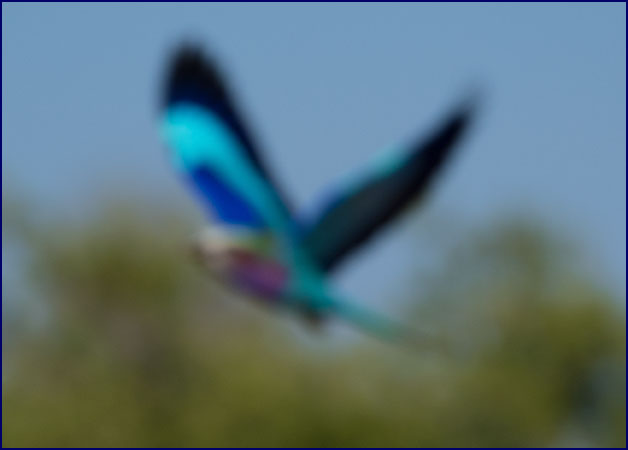
Hard to get those
lilac-breasted rollers in focus when they fly!
|
A family of waterbucks stood close to the road; mom, dad
and a half-grown son. I wondered; would a male waterbuck be called
a waterbuck buck?
There is something incredibly appealing about these
deer-like antelope; they have beautiful eyes and a kind
expression. With their thick soft coats they somehow look a little
out of place, like they might belong in Alaska instead of Africa.
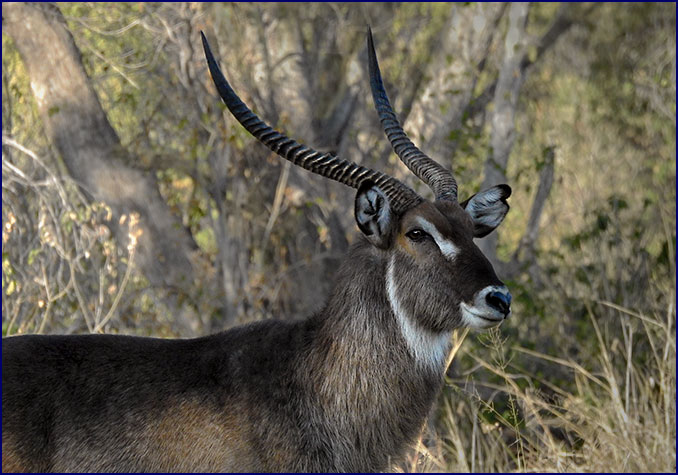
Waterbuck
|
Gee had gotten a report that there were lions in the area,
so we went scouting around trying to find them. We crossed several
more deep watercourses, the element of uncertainty about whether
we would get stuck adding to the adventure. Several big stately
rain trees stood like sentinels, their pods hanging down in little
cascades. A business of
banded mongoose moved by, flowing over the ground like a tide. Gee
pointed out some round green fruits growing from a vine in a tree;
they were summer melons, he told us, and ostriches, baboons and
monkeys all eat them.
We stopped to watch a small band of elephants. Gee pointed
out how several of them were ‘weeping’ from the temporal gland
on the side of their heads; this usually indicates stress. They
can also have this secretion when they are coming into breeding
condition.
About 15 zebras were grazing near
the road; they were a particularly charismatic herd. The evening
light was good for photography and they posed for us nicely,
turning around to show off their lovely round striped bottoms, as
zebras like to do.
Suddenly shrill screams rang out. A huge bull elephant came
crashing through the bushes, wheeling and trumpeting, and then
another one followed right behind him. The two of them were
running fast, screaming in apparent rage. It was a fearsome sight.
Gee told us the two bulls were in musth,
a condition brought on by the rise in reproductive hormones when
they are ready to breed. The bulls become highly aggressive during
this time, and their urine takes on a unique odor. They were
following a female in estrus; both the male and female elephant
must be in breeding condition to mate.
The two bulls charged past us and
disappeared into the woods. Gee said they would follow the female,
running hard, and she would just keep running away, going until
she was exhausted - the epitome of playing ‘hard to get.’ The
male who could follow the fastest and furthest would win her;
presumably the one with the most speed and endurance would father
better babies.
We could
hear the enraged elephants crashing and screaming in the forest
behind us. Several in our party wanted to go follow them; Gee
wasn’t so sure, but against his better judgement he turned
around and entered the woods in search of them. We were in a
narrow lane through the trees when suddenly one of the musth bulls
came up behind us, trumpeting savagely and advancing toward us.
The people in the back of the Landcruiser, seeing those tusks
gaining ground on us, urged Gee to go faster. As Gee drove us
swiftly out of the angry bull’s path, he scolded us; “Well,
you said you wanted to
see them!” We hadn’t meant to interfere with his guiding, but
it was pretty amazing to
get to see such immense strength and angry power.
Then we heard the shrill
trumpeting of yet another angry elephant in musth, following the
first two after the same female. He came across the water towards
us and Gee had to maneuver quickly out of his way; you don’t
mess around with elephants in musth. “They don’t respect the
bush!” Gee commented.
Pausing beside a small river, we could hear the
whistling call of a pearl-spotted owlet. A red-eyed dove flew down
to the edge of the water for a drink. Suddenly Gee excitedly
pointed out a tall white wading bird with a long up-curving beak;
the top half of his head was black, as were the edges of his
wings. It was an avocet, a bird that Gee had never seen before; we
were happy to be able to share a first sighting with him.
|
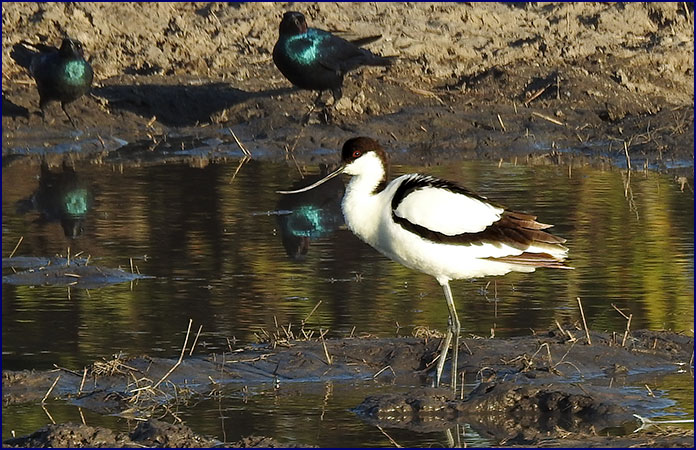
Avocet
|
The sun was getting low as we made our way back to the
zebras. Other animals had arrived on the scene; now we had
wildebeest on the right, impala on the left, and warthogs straight
ahead. We watched a trio of kudu bulls with magnificent twisting
horns walking quietly along, their thin white stripes helping them
blend into the trees.
We found the lions. A big male was sleeping at the edge of
a floodplain. He was lying sprawled on his back in a most
undignified position, twitching and batting at flies. There was
another pair of lions sleeping right beside the road, so close
that when a vehicle went by it was just inches from them. Why take
your nap that close to the road? Apparently the lions have been
sleeping all day - a lot like my housecats at home.
|
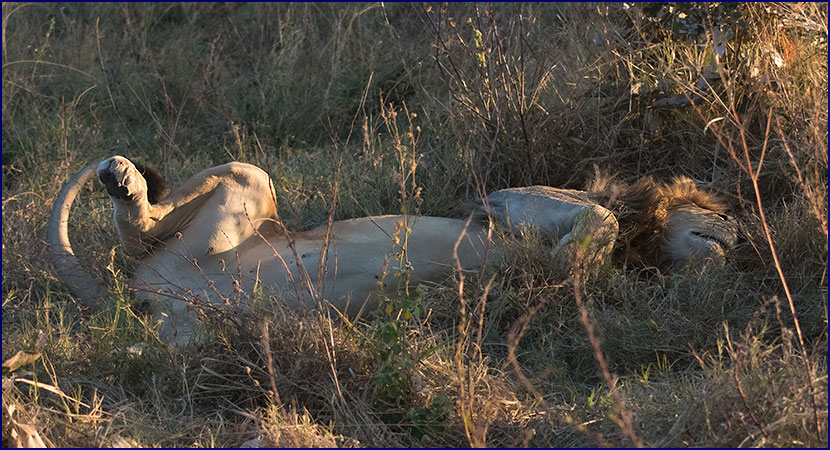
Very dignified!
|
Several other safari vehicles were there, but one by one
they left, until finally it was just us and the lions. The sun
neared the horizon and the light was getting dim, but in Khwai you
don’t have to be in camp by dark. We had Sundowners
with the lions; this is an African custom where you enjoy a drink
in a beautiful spot while watching the sunset. We broke out the
wine and passed around some snacks, then watched the sky turn
orange and magenta, the sun-colors reflecting in the lagoon.
It was dark when we set out for camp, and Gee swept the
spotlight from side to side as he drove. We could see zebras
crossing ahead of us in the dark, their white stripes glowing
faintly, like creatures from a dream. Gee stopped the Landcruiser
and cut the engine, and we sat in the dark and just listened for a
while. We could hear the hooting of a scops owl and the chorus of
frogs. When we went on, the spotlight found a scrub hare crouching
in the grass, and we saw a new bird, the thick-knee.
We saw springhares again, to my delight – I am completely
smitten with them. The spotlight caught the gleam of eyes, and we
could see them hopping through the grass. Gee put a red filter on
the light to avoid interfering with their night vision, and we got
a good look at one caught frozen in the beam. With face and ears
like a rabbit and a bushy bottlebrush tail, he sat up on strong
hindquarters, his tiny front legs held up in front of him in a
kangaroo-like stance. He was marvelous.
|
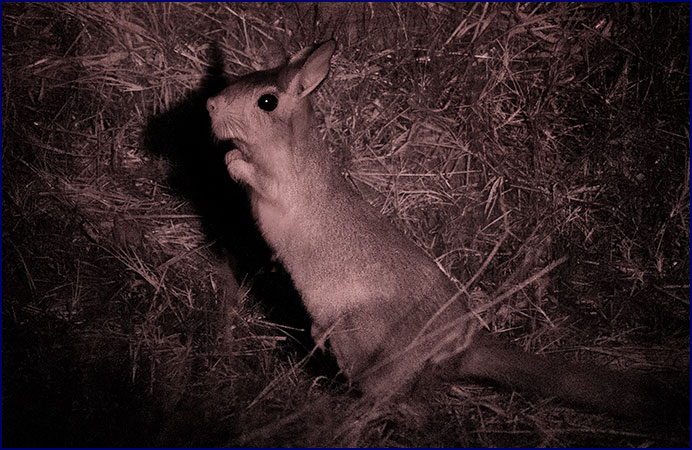
Springhare
|
We came to an area where bushbabies might live, and Gee
swept the light up into the trees. We could just catch a glimpse
of eyes in the spotlight as several bushbabies moved through the
branches. Fred was very excited.
Properly known as the lesser
galago, the bushbaby is one of the smallest African primates, only
about 14 inches long, not counting the tail. They have large,
round mobile ears, a tiny pointed snout and huge eyes. They are a
silvery grey color and have a long bushy tail. They are nocturnal,
and live up in the trees. We would have loved a better look at one
of these adorable animals, but for a close-up view we would just
have to be content with Fred.
|
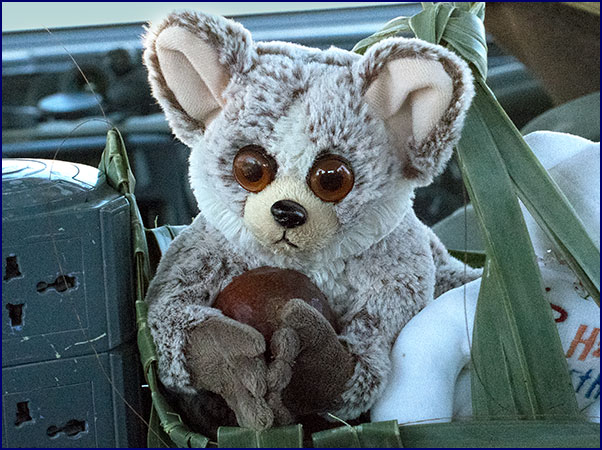
Fred the bushbaby
|
Back at camp, we had our usual routine: Each evening we
would have G&Ts and wine around the campfire with Gee, and
talk about the day. Presently Pula would come and shyly announce
dinner, telling us about each course. After we ate we would gather
around the fire for a while longer, before heading to our tents
for the night, where we would snuggle with our bushbaby
hot water bottles.
The laughing calls of the hippos
and the trumpeting of elephants filled the night. There was a
symphony of frogs, rising and falling in pitch. We heard the soft
whoop-whoop of hyenas in the night, and again in the morning. It
was sweet music to sleep to.
|